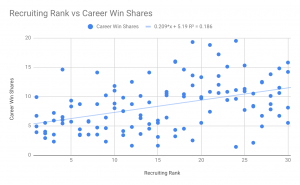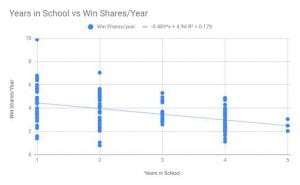Authors: Leo Georgopoulos (McCormick ’22) and Jordi Parry (Weinberg ’22)
The NBA’s “one-and-done” rule is one of the most controversial subjects in all of sports. However, elite coaches like John Calipari and Mike Krzyzewski have tapped into this rule, running something between college programs and NBA prep programs by running out lineups full of highly touted freshmen. In spite of this, the last three NCAA titles have been won by Villanova and UNC teams whose top contributors were mostly low-end five-star or four-star recruits, a far cry from the surefire lottery picks filling Duke and Kentucky’s lineups in recent years. During this project, we investigated whether it is actually more valuable to a college program to target recruits who are likely to stay with the school for 2-4 years before heading off to the pros than to recruit players who may have a much larger impact in year one but are as good as gone after the one year.
We did this by looking at ESPN’s top 30 college recruits for the 2011-2014 high school graduating classes, all of which have completed their college basketball careers by now, and compared their total career win shares (CWS) from Sports Reference, as well as their WS per year. Two players ranked top 30 never played in college (Emmanuel Mudiay, the #5 recruit in 2014, opted to earn a paycheck playing overseas, while Ricky Ledo, 2012’s #21 recruit was declared ineligible for NCAA play), lowering total sample size down to 118. We predicted that the lower half of the top 30 would have a higher overall CWS but a lower CWS per year since they normally would play longer but not be as skilled as the upper half, and we predicted the upper half of the top 30 to exhibit the opposite relationship for the same reasons.
Our experimentation supported our hypothesis. Upon investigation, we found the upper half of the top 30 to average 1.80 years in the NCAA, have a CWS of 6.43, and WS per year of 4.02 (it should also be noted that without Anthony Davis, this number falls to 3.92), while the lower half had an average of 3.15 years in school, a CWS of 10.47, and WS per year of 3.44. All of these numbers were found to be significantly different at the ɑ=0.05 level.
After finding that, we decided to look a little deeper into the general data to see if a significant positive linear relationship existed between the factors we discussed. Such linear regressions can be seen below.
At first glance this is what we predicted; rank has a positive relationship with CWS, and a negative relationship with WS per year, while years in school had a positive relationship with CWS and a negative relationship with WS per year. But upon further inspection, most r2 values were very weak, and some of the regression line slopes were very close to 0, so we decided to do a linear regression t-test to check whether the slopes were not equal to zero at the ɑ=0.05 level. Doing this, we found that none of the plots have a statistically significant regression line slope. This isn’t surprising given the large variation in the data around the regression line, but brings up a very interesting counterpoint to the previous findings. Eyeballing the WS per year graphs in particular, you can see that that you don’t need to be a top 15 recruit or play for only a season to do well; as long as you set your mind to the game and work well with your team, you can find success in the sport.
In all, although on the surface we did find convincing evidence that top 15 recruits spend less time in the NCAA and have a larger WS per game, upon digging deeper into the issue, we found that even non-top 15 recruits have a very real chance of making an impact on the team. If continued in the future, we would look at how much success these people have in the NBA, since WS is a team-based statistic and it’s easier to have higher WS on a worse team, so comparing these players on a slightly more level playing field such as NBA draft position might provide a more informative metric for comparison.





Be the first to comment on "Examining the Relationship between Recruiting, One-and-Done Players and Team Success"